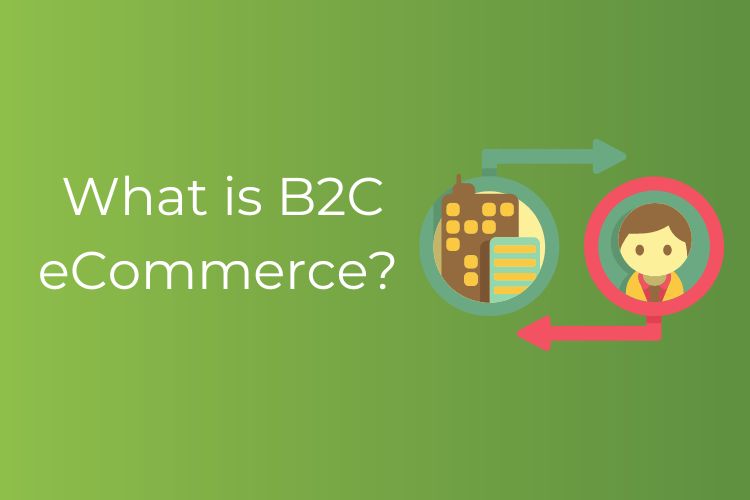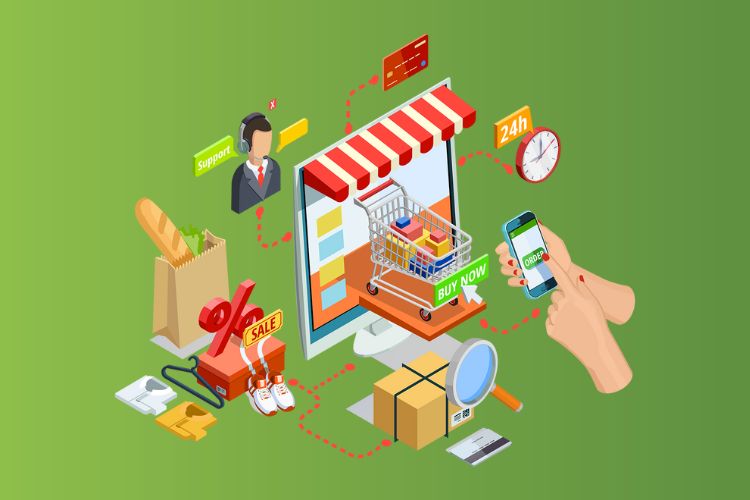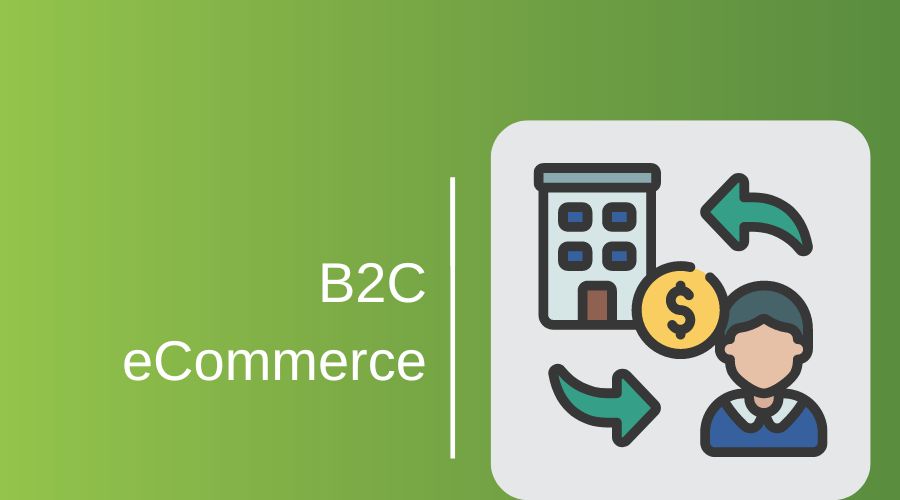It is accurate to claim that the B2C eCommerce model is well-known to the majority of Internet consumers. B2C eCommerce is practiced when you purchase any good or service online for private out-of-pocket use from a brand. Customers appreciate the convenience of online shopping, where they can get services like apparel, electronics, and media subscriptions.
At the outbreak of the pandemic in 2020, billions of consumers changed their regular buying habits and started purchasing food, clothing, and entertainment subscriptions on the internet. For the above reason, B2C eCommerce has had a meteoric rise. In this article, we will find out B2C eCommerce and get the hang of B2C eCommerce.
1. What is B2C eCommerce?

B2C is the abbreviation for Business to Customer referring to a form of various business models in eCommerce. Firms sell their product directly to customers online or via a mobile device, which means B2C eCommerce. The phrase was largely used to refer to techniques for directly marketing items to end consumers, such as commercial centers, infomercials, pay-per-view television, and dining out.
Amazon, eBay, and Alibaba are among the top B2C eCommerce companies. It’s also important to realize that B2C businesses don’t have to be purely online like Amazon and eBay. B2C businesses can also open a physical store and, if it makes sense, can create an e-commerce site. Large fashion businesses such as Nordstrom, J. Crew, H&M, and others are typical examples.
Besides, B2C doesn’t just refer to items; it also consists of services. B2C innovators have taken advantage of technologies such as mobile apps, native advertising, and remarketing to promote directly to their customers. This makes life easier for them.
Consumers may quickly connect with local lawn mowing businesses, garden, and patio specialists, or snow removal pros using an app like Lawn Guru.
Housecall Pro’s plumbing software app also allows home service businesses to track personnel routes, text consumers, and credit card payments on the move, which benefits both the consumer and the business.
2. The growth of B2C eCommerce
E-commerce development is developing quickly. Sales of e-commerce in the US are anticipated to increase by 32.4 percent annually to $794.50 billion by 2020. This is higher than the 18.0 % predicted for Q2 due to the fact that consumers continue to avoid stores and stay out of the pandemic for online shopping transactions. The revenue of e-commerce accounts for 14.4% of all US retail spending this year and is expected to be 19.2% by 2024. If gasoline and auto sales are not included, the penetration of e-commerce will increase to 20.6%. (Categories that are sold almost entirely offline).
3. What are the types of B2C eCommerce businesses?
B2C eCommerce participants have huge potential in local and niche fragmentation, just like in any new market. Different winning strategies apply to national closed retailing, theme-based online shops, specialized deal aggregators, and international multichannel distributors. However, the main challenges remain much the same for all B2C online shops.
3.1 Direct sellers

When most people hear “B2C eCommerce,” they imagine direct sellers. Selling products and services directly to customers is a particularly efficient strategy in the business-to-consumer market. This often refers to a direct transaction between a vendor and a buyer.
In reality, direct selling works quite effectively to attract specific groups of buyers whose contacts and purchasing inclinations are known. These individuals might be sports enthusiasts, hobbyists, owners of exclusive vehicles or vessels, etc.
For instance, anglers and hunters frequently submit their contact information at specialist shops or the websites of ammunition manufacturers. In this approach, they can receive information from the publication of new fishing rods or hunting gear and then be directly sold such products, including home delivery.
3.2 Online intermediaries
The wide-ranging service providers that enable online interactions between customers and retailers are referred to as “internet intermediaries” or “online intermediaries” in B2C eCommerce. These businesses host numerous web services, process data, and link customers to distinct websites.
Online intermediaries frequently offer services for the replication of media content in global networks (SLI) in the sector of B2C eCommerce and encourage the sale of goods and services which also have interactive geo maps.
Most significantly, internet intermediaries give customers instant access to a vast quantity of information and help them find nearby offline POS around the shopper’s location or local online retailers with local delivery.
3.3 Advertisement-based

The goal of the advertising-based B2C model is to draw customers with compelling and practical information. On news websites and significant forums, the B2C model performs particularly well. Stockholders of resources make money by placing advertisements on their websites.
Additionally, websites that receive a lot of traffic from both men and women, like Cosmopolitan and Men’s Health, can make money via product placement in their content (pictures, videos, and articles).
3.4 Community-based
If you are genuinely concerned about a certain issue being discussed online, you probably belong to Facebook groups for people who share that interest or you probably follow an Instagram influencer. Such a group is typically managed by a businessman or coach who moderates the members.
Once they have attracted a sufficient number of participants, they begin using the group to advertise goods and services and generate revenue on the network. Members of these online communities are already warmed up as potential customers. Besides, These potential customers can share the information with acquaintances and post it on their social networks.
3.5 Fee-based
Entertaining websites, like Netflix or Disney, charge users to access their material. Of course, some of the information will be available for free to demonstrate the site’s value, but the best content is only accessible through registering the account. The sites of adult content make up the largest market segment in this B2C business.
4. List of B2C eCommerce examples
3.1 Netflix

With millions of customers continually increasing, Netflix becomes one of the largest suppliers. The rise in popularity of internet TV confirms the position of online television networks worldwide. Customers of this company can enjoy their mind-blowing TV experience regardless of the time, place, or availability in their country.
4.2 Tesco
One of the biggest grocery chains in the world is Tesco. It provides people with everything they need, including food, beverages, FMCG, and other things. This brand has seen a surge in sales as a result of technology and innovation including AR, big data, and mobile shopping. Its objective is to make Tesco a multi-channel provider, which will be important for distribution in the future. The new tablet and smartphone applications of the company will greatly enhance the shopping experience.
4.3 Lay’s
It is among the most well-known brands in the B2C eCommerce sector. Lay’s may have a more traditional flavor for this type of food when compared to other crunchy snacks on the market right now. But there’s no denying that Lay’s knows how to maintain brand interest and shrewdly change its image.
Every year, the company organizes a digital vote where customers can choose one of three new flavors that will be a staple flavor of Lay’s potatoes. The top three tastes are offered almost throughout the year in a select few places around the nation. Best of all, during this yearly competition, the brand has a notable increase in consumption.
5. What are the benefits of B2C e-commerce?
B2C e-commerce models have attributed to a number of potential advantages, such as:
5.1 Globalization
Target audiences for larger-scale B2C enterprises are usually enormous. Therefore, through the internet and social media, advertisements, and marketing efforts can reach millions of potential clients.
5.2 Relatively low cost

Costs associated with infrastructure and operations can be reduced by using B2C e-commerce solutions.
5.3 Customer personalization
B2C businesses can directly market to consumer segments and specialty target markets, which enables businesses to tailor their marketing to each individual customer.
5.4 Customer data
A company’s marketing strategy can be strengthened by using valuable customer data, which includes sales conversion statistics, email addresses for marketing automation, analytics, customer behavior patterns, geographic regions, and psychographics.
6. What are the challenges of B2C eCommerce?
In comparison to the business-to-business model, B2C eCommerce has far more competition and higher client demands. If we take a deeper look at the B2C store success formula, we can highlight the following prominent factors:
6.1 Consumer traffic

You don’t exist if Google, Bing, or Yahoo! don’t know your name. Any online business depends heavily on search engine marketing and optimization. The typical search result user action is to click on a link on the first or second page. The structure, architecture, and content management system of a B2C website must be optimized from the start in order to attract traffic. For all the above reasons, the platform that a website is built on is crucial to its success.
6.2 Payment processing
Due to security concerns, many users are reluctant to provide websites with their personal information. Online customers’ trust is increased by SSL encryption, PCI compliance.
6.3 Client support

The biggest focus should be on increasing retention because a better customer experience encourages visitors to become devoted patrons. It is necessary to have many strategies to help make clients feel appreciated. Online buying must be simple and inspiring for customers to join you as partners and brand ambassadors. Strong, user-friendly easy technologies that support these strategies can be used to create effective promotions, campaigns, and loyalty programs.
6.4 Product findability
Online shops are becoming slicker, more user-friendly, and more direct. One of the most important aspects of usability is how easy it is to search and navigate the website. The associations, particular jargon, abbreviations, search dictionary’s autocomplete suggestions, filters, refinements, as well as a clear product hierarchy are crucial elements that significantly boost conversion rates.
A customer cannot purchase a thing if he cannot locate it. Usability-related technologies must be included in an online store platform to make the search process as simple as feasible for customers who return to orders again.
7. What are the differences between B2C and B2B eCommerce?
The primary difference between the B2B and B2C eCommerce depends on determining who firms sell to. B2B companies sell to other businesses, whereas B2C companies sell directly to consumers.
B2B purchases are best characterized as “rational” because the decision-makers frequently confer with other workers to make sure the purchase satisfies a predetermined set of requirements. As a result, the sales procedure is much lengthier and more complicated. B2B consumers may need several proposals from various vendors before making a final choice.
Contrarily, B2C purchasing decisions are typically made by a single individual and involve one-off purchases (unless the customer chooses a subscription-based product or service). As a result, it’s not surprising that B2C customers are notorious for impulsive spending since they are much more likely to base their decision on emotion than on logic.
As part of their marketing plans, B2C marketers occasionally need to generate and convey the desires which consumers have for their goods and services. The marketer’s task is to persuade customers that they need to use your products, particularly if they are unaware of this need.
B2C purchases are primarily motivated by the product itself, the price, and the convenience it offers, whereas B2B purchases are more likely to be driven by the relationship between the buyer and supplier as well as whether the product has a track record of performance.
B2C businesses frequently target a large number of potential customers representing a diverse variety of demographics. This makes sense that B2C brands typically sell accessible goods and services.
8. Salesforce B2C eCommerce

8.1 Commerce Storefront
The B2C economy brands can customize the experience via the Storefront eCommerce module. Based on mobile-first best practices, the Storefront Front Reference Architecture (SFRA) enables firms to rapidly and easily design and launch websites so they can deliver their products to customers.
8.2 B2C eCommerce Extensions
Brands can link with various third-party applications and social media sites like Facebook and Twitter through B2C Commerce APIs to improve and support the eCommerce store’s marketing initiatives. Brands can expand their reach into previously new and diverse markets inaccessible with the use of commerce extensions.



Leave a Reply